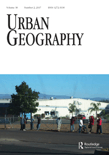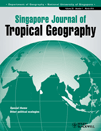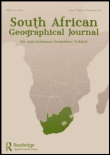
Southeastern Geographer
Scope & Guideline
Advancing Insights in Earth and Planetary Sciences
Introduction
Aims and Scopes
- Urban Geography and Planning:
The journal frequently addresses themes related to urban development, infrastructure, and transportation planning, reflecting the complexities of urbanization in southeastern cities. - Environmental Geography and Climate Change:
Research articles often explore the impacts of climate change and environmental management strategies, particularly in relation to coastal regions and natural resource conservation. - Social Justice and Inequality:
A consistent focus on issues of race, class, and social justice is prevalent, with studies examining the socio-spatial dynamics of marginalized communities and the historical context of these disparities. - Cultural and Historical Geography:
The journal includes analyses of cultural landscapes and historical narratives, providing insights into how history shapes contemporary geographic identities and practices. - Ecological Studies and Conservation:
Research on biodiversity, ecological restoration, and conservation efforts in the southeastern U.S. contributes to understanding the region's natural heritage and environmental challenges.
Trending and Emerging
- Climate Resilience and Adaptation:
There is a growing emphasis on climate resilience strategies, particularly in coastal regions, highlighting the need to address vulnerabilities and promote sustainable practices. - Social Vulnerability and Health Disparities:
An increase in studies examining social vulnerability, especially in the context of health outcomes during crises such as the COVID-19 pandemic, underscores the journal's commitment to addressing inequities. - Urban Equity and Transportation Justice:
Research focusing on transportation equity and urban planning is gaining traction, reflecting a broader dialogue on accessibility and the impacts of urban infrastructure on marginalized communities. - Cultural Geographies and Identity:
Emerging themes related to cultural geography, identity formation, and the representation of diverse communities are being explored, particularly in relation to race and ethnicity. - Technological Integration in Geography:
The use of advanced technologies, such as UAV imagery and GIS, is increasingly prevalent in research, demonstrating a trend towards integrating technology with geographical analysis.
Declining or Waning
- Traditional Economic Geography:
There has been a notable decrease in research that focuses explicitly on traditional economic geography, particularly studies centered on industrial development and economic growth metrics in the region. - Rural Geography:
Articles specifically addressing rural issues, such as agricultural practices or rural-urban migration patterns, seem to be less frequent compared to urban-focused studies. - Political Geography and Geopolitical Studies:
Research that delves into political geography and the geopolitics of the Southeastern U.S. has seen a reduction, possibly overshadowed by more pressing social and environmental concerns. - Historical Geographies of Slavery and Civil War,:
While still important, the volume of papers specifically addressing the historical geography of slavery and the Civil War appears to be waning, with fewer studies published in recent volumes.
Similar Journals

URBAN GEOGRAPHY
Exploring the Dynamics of Urban LandscapesURBAN GEOGRAPHY, published by Routledge Journals, Taylor & Francis Ltd, is a leading interdisciplinary journal that has been at the forefront of urban studies since its inception in 1980. With an impact factor that positions it in the prestigious Q1 category in both Geography, Planning and Development and Urban Studies, this journal is recognized for its rigorous research that informs policy and practice in urban environments. With a Scopus ranking of #20 out of 279 in the field of Urban Studies and #79 out of 821 in Geography, Planning and Development, it offers valuable insights for scholars, professionals, and students alike—enhancing our understanding of the complex dynamics that shape urban spaces. URBAN GEOGRAPHY is pivotal for those looking to advance their expertise in urban analytical frameworks, urbanization trends, and sustainable development strategies. Submissions are welcomed from a diverse range of perspectives, making it a vital resource for anyone invested in the future of urban landscapes.

Urban Science
Advancing Sustainable Solutions for Modern CitiesUrban Science, published by MDPI in Switzerland, is a pioneering open access journal that has been serving the academic community since 2017. With a robust focus on understanding urban environments through various interdisciplinary lenses such as Environmental Science, Geography, Planning and Development, and Urban Studies, this journal aims to advance knowledge on the complexities of urban living and the challenges that modern cities face. Recognized for its impact, Urban Science holds prestigious rankings, including Q1 in Urban Studies and Q2 in multiple relevant categories. Its presence in leading databases like Scopus, where it stands among the top percentile ranks, underscores its contribution to critical dialogues in urban research. The journal’s commitment to accessibility, targeted toward researchers, professionals, and students alike, fosters an inclusive platform for disseminating innovative ideas and solutions necessary for sustainable urban development.

Cadernos de Geografia
Navigating the Future of Geography and Social SciencesCadernos de Geografia is a distinguished biannual journal published by UNIVERSIDADE DE COIMBRA, FACULDADE DE LETRAS, dedicated to the field of geography and related social sciences. With its ISSN 0871-1623 and E-ISSN 2183-4016, this journal has been a prominent platform for the dissemination of high-quality research since it became open access in 2012. Situated in Coimbra, Portugal, it aims to foster academic excellence by providing an inclusive space for innovative studies that explore contemporary geographical issues. Cadernos de Geografia encourages submissions that address diverse aspects of geography, ranging from environmental studies to urban planning, making it an invaluable resource for researchers, professionals, and students alike. As a part of the growing trend in open-access publishing, it enhances the global reach and accessibility of geographical research, thereby contributing to the enrichment of knowledge in the field.

Geographica Pannonica
Unveiling Insights into Earth and SocietyGeographica Pannonica is a premier, open-access journal dedicated to the various dimensions of geography, atmospheric sciences, geology, and related fields. Published by the University of Novi Sad's Faculty of Natural Sciences and Mathematics, this Serbian journal has been a vital platform for scholarly discourse since its inception, with an open-access policy established in 2010 to enhance the dissemination of research findings. Covering a spectrum of topics from Earth-surface processes to tourism management, the journal has achieved notable rankings, reflecting its commitment to impactful research—ranking in the Q3 quartile across multiple categories in 2023. Researchers, professionals, and students are encouraged to engage with the latest articles that contribute to advancing our understanding of geographical phenomena and sustainability challenges, making Geographica Pannonica an essential resource for the global academic community.

Journal of Geography-Cografya Dergisi
Advancing Knowledge, Connecting LandscapesJournal of Geography-Cografya Dergisi, with ISSN 1302-7212 and E-ISSN 1305-2128, is an esteemed publication in the field of geography, dedicated to advancing scholarly research and knowledge in this vital discipline. Published by the Faculté des Lettres, Department of Geography at Istanbul University, this journal has embraced an Open Access policy since 2017, ensuring that cutting-edge research is freely accessible to a global audience, thereby fostering interdisciplinary collaboration and widening the dissemination of geographical studies. The journal aims to publish high-quality research articles, reviews, and case studies that address contemporary geographical challenges, methods, and innovations, appealing to researchers, professionals, and students alike. With its strategic location in Istanbul, a city that exemplifies a rich tapestry of geographical phenomena, the journal holds a vital role in connecting scholars with the diverse landscapes and cultural experiences that shape our understanding of geography. Join the vibrant community of geography enthusiasts and contribute to the ongoing dialogue within this dynamic field.

SINGAPORE JOURNAL OF TROPICAL GEOGRAPHY
Illuminating Earth-Surface Processes in the TropicsThe Singapore Journal of Tropical Geography, published by Wiley, stands as a premier platform dedicated to the discourse on tropical geography, making significant contributions to the fields of Earth-Surface Processes and Geography, Planning, and Development. With an esteemed Q2 categorization in these areas, as per the 2023 rankings, this journal engages a diverse audience of researchers, professionals, and students committed to understanding the complex dynamics of tropical environments. Originating in 1980, the journal has maintained a consistent publication rhythm that extends through 2024, ensuring timely dissemination of cutting-edge research. Although not an open-access journal, it provides valuable insights and rigorous assessments that are beneficial to anyone involved in the study of geography and planetary sciences. Researchers looking for authoritative content will find the journal's robust rankings—ranked #205 out of 821 in Social Sciences and #54 out of 179 in Earth and Planetary Sciences—indicative of its impactful contribution to academia.

Geograficando
Exploring the Depths of Geography and Interdisciplinary InsightsGeograficando is a distinguished scholarly journal dedicated to the field of geography and its interdisciplinary applications, published by the Universidad Nacional de La Plata, in collaboration with the Facultad de Humanidades y Ciencias de la Educación. Since its establishment, this Open Access journal has made significant strides in advancing geographical research and discourse, enhancing visibility and accessibility for scholars around the globe since 2013. With an ISSN of 1850-1885 and an E-ISSN of 2346-898X, Geograficando provides a platform for innovative research articles, critical reviews, and case studies that address contemporary geographical challenges and promote sustainable development practices. The journal serves as a vital resource for researchers, professionals, and students alike, fostering a rich exchange of ideas and findings that contribute to both academic and practical advancements in the field.

Geografie
Fostering innovative solutions through rigorous research.Geografie, published by the Czech Geographic Society, serves as a vital resource in the fields of geography, planning, and development. With an E-ISSN of 1212-0014, this esteemed journal has been contributing to the academic landscape since its inception in 1992, providing a platform for rigorous research and diverse perspectives on earth-surface processes and regional development issues. Based in the heart of Prague at Charles University, it has reached an impressive convergence of scholarly excellence, ranking in the Q3 category for both Earth-Surface Processes and Geography, Planning and Development as of 2023. Although it does not currently offer open access, the journal is indexed in Scopus, holding significant positions within its realms—392nd out of 821 in Social Sciences and 89th out of 179 in Earth and Planetary Sciences—indicating its relevance and contribution to ongoing discussions in both disciplines. As an indispensable tool for researchers, professionals, and students alike, Geografie not only enhances the understanding of spatial processes but also fosters innovative solutions for contemporary geographical challenges.

Quaestiones Geographicae
Advancing Earth Sciences Through Open DialogueQuaestiones Geographicae, an esteemed open-access journal published by SCIENDO, serves as a vital platform for scholarly communication in the field of Earth and Planetary Sciences. Since its inception in 1979, the journal has been dedicated to promoting rigorous research and discourse in geography, encompassing a breadth of topics that reflect the dynamic nature of the discipline. With an impressive Impact Factor belonging to the Q3 quartile category, the journal actively contributes to the global scientific community's understanding of geographical phenomena. Its commitment to open-access publishing since 2010 ensures that groundbreaking research is accessible to a wider audience, facilitating collaboration and innovation. As part of its enduring legacy, Quaestiones Geographicae engages researchers, professionals, and students alike, inviting them to explore, share, and expand the boundaries of geographical knowledge.

South African Geographical Journal
Exploring the dynamic landscapes of South Africa and beyond.The South African Geographical Journal, published by Routledge Journals, Taylor & Francis Ltd, is a leading scholarly platform dedicated to advancing research in the fields of geography, planning, and development. With an impressive history spanning from 1931 to 2024, this journal not only retains its relevance in the academic community but also proudly holds a Q2 rank in both Earth and Planetary Sciences and Geography, Planning and Development, marking it as a significant contributor to the scholarly discourse. The journal is ranked in the top 32% of its category within Scopus, affirming its stature among researchers and professionals. Although it currently does not offer Open Access, the journal provides a critical forum for the exchange of ideas, methodologies, and findings, encouraging dialogue that informs policy and practice in the geographical sciences. Readers can expect a rich variety of articles that encompass both theoretical and practical aspects of geography, making it essential for academics and practitioners alike.